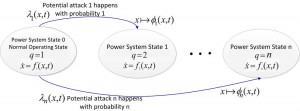Quantifying the Impacts on Reliability of Coupling Between Cyber and Physical Components
Jiangmeng Zhang with adviser A. Domínguez-García
Uncertainties are the main factors that impact power system reliability and are caused by both cyber and physical components. Renewable-based generation varying from forecast values is one example of physical uncertainty. Another is unavoidable measurement noises through communication channels. These measurements are also vulnerable to malicious cyber-attacks. Therefore, it is critical to assess the impacts of these measurements on system performance. To this end, we are formulating a model, automatic generation control (AGC), where AGC is a vital control mechanism in power systems to maintain nominal frequency and real power interchange as scheduled.
To quantify the impacts on system reliability of uncertainties from cyber and physical components, we formulate a comprehensive power system model with AGC, including the uncertain factors from cyber and physical components, using a set of stochastic differential-algebraic equations. Potential attacks (for instance, information packages that are tampered with during communication) will cause the power system operating state to jump to another state, as illustrated in Fig. 21. A powerful mathematics theorem, Dynkin’s formula, is used with this hybrid stochastic mode to evaluate the system performance metrics statistics. Depending on the system model parameters, a classical “closure problem” may arise when applying Dynkin’s formula. We were able to resolve this problem by developing a method based on a maximum entropy assumption to obtain approximate system state statistics in the long term.
This research is supported by the Trustworthy Cyber Infrastructure for the Power Grid (TCIPG).
